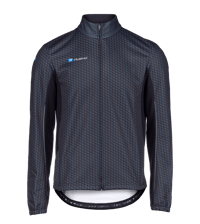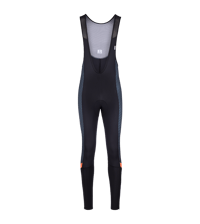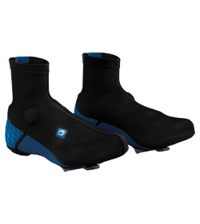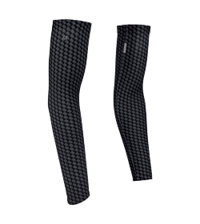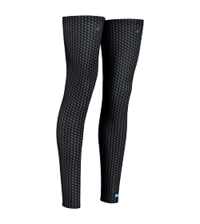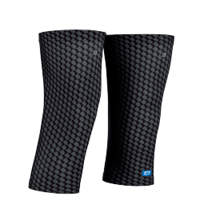Road bike in winter: Tips & tricks
How to ride your road bike safely in winter and spring
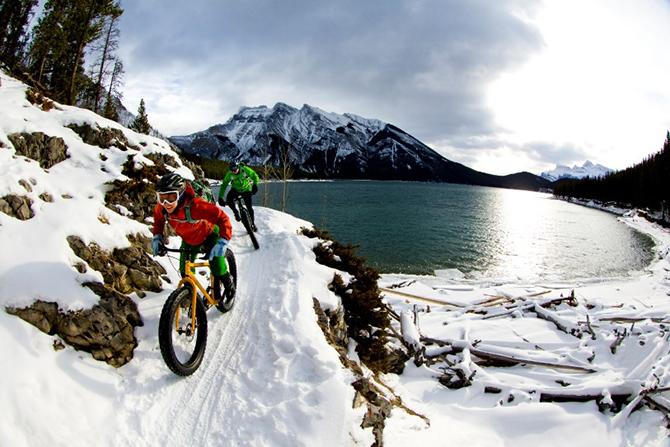
Road cycling in sub-zero temperatures? No problem! We'll show you how you don't have to give up your favorite sport even in cold temperatures. We have compiled the most important tips and information on road cycling in winter so that you can still have fun and stay safe.
Contents:
- Road biking in winter: The most important things at a glance
- How can I prepare my road bike for winter?
- How do I care for and store my road bike in winter?
- What clothes should I wear when road biking in winter?
- Eating and drinking: What should I eat when road biking in winter?
- Road biking in winter and health: What you need to consider
- Safe on the road: Road biking in winter and snow
Road cycling in winter: The most important things at a glance
With a little preparation and the right clothing, you and your mountain or road bike will get through the winter well. We have summarized the most important points for you at a glance:
- Equipment for the road bike: winter/studded tyres, lights and mudguards
- Storage of the road bike: dry and not too cold
- Care of the road bike: clean from snow and salt and regularly oil the chain
- Clothing: winter-proof and light
- Nutrition: lukewarm drinks and snacks rich in carbohydrates
How can I prepare my road bike for winter?
First things first: In icy and snowy conditions, roads that are not wind-protected quickly become uncomfortable. That’s why we recommend all road bike enthusiasts switch to a cyclocross bike or mountain bike in winter. These bikes are designed for rough terrain. Additionally, forest trails naturally slow down speed, reducing the risk of falling and minimizing the cold wind while riding.
If you plan to ride regularly in the snow, you should get a fatbike. This newly developed off-road and expedition bike has extremely thick tires, which allows for easier off-road cycling.
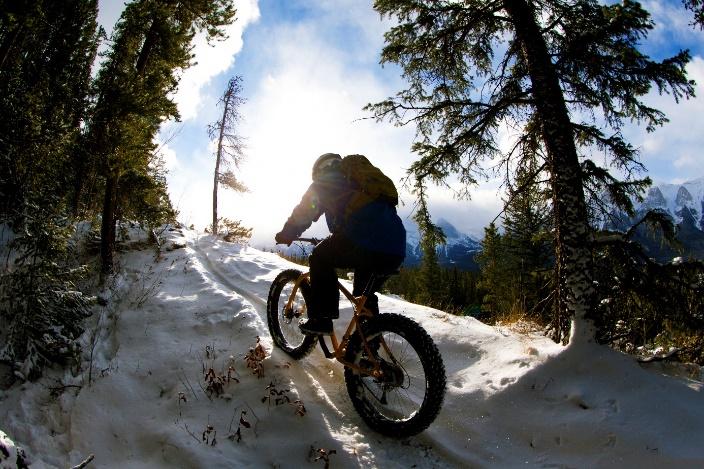
Winter and studded tires for your road bike
But even occasional cyclists who do not own a mountain bike or fatbike do not have to give up riding if the bike path has not been cleared of snow. Specialized bike shops offers winter and studded tires for such cases. After the modification, you can ride relatively safely even on ice and snow.
Safe on the road with your road bike in winter: The right lighting
A properly installed light system ensures safety. Your road bike light should conform to the Road Traffic Licensing Regulation of your area, which usually consists of a front headlight with a white reflector, a rear light and a red reflector plus reflectors in the spokes and on the pedals. Please check what the regulations are in your area.
Also practical are helmet-integrated lights or headlamps, which are not always approved as official bicycle lights by Road Traffic Licensing Regulations, but can be especially helpful on badly lit paths. In road traffic, however, it's better if possible to do without headlamps, because you can dazzle other road users and you may have to pay a fine if stopped by the police.
Mudguards for your road bike
Road bikes and mudguards – they don’t go together, do they? Aesthetically, a mudguard on a road bike might not be the most appealing choice, but in practice, it makes a lot of sense, especially in winter. Mudguards prevent dirt, water, or small stones from being thrown onto your bike frame or clothing. They also help keep snow and road salt, which can damage sensitive bike components, away from the frame. In winter, these protective accessories are a smart investment, as they can be easily attached to your road bike using clips, Velcro straps, or rubber bands. Choose models made of carbon, plastic, or aluminum – this way, your road bike stays aerodynamic and lightweight even in winter. A special option is the so-called Ass Saver, a small, flexible plastic mudguard that can be attached under the saddle. If you no longer need it, you can simply fold it up under the saddle.
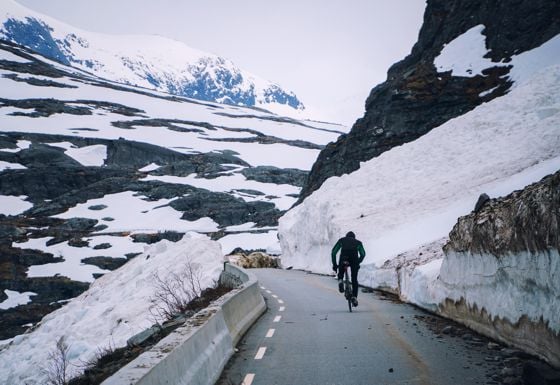
How do I care for and store my road bike in winter?
Whether you park your road bike or mountain bike for a short time or store it for a longer period make sure that it is dry and not too cold. Sheds or cellars, for example, are a option as storage locations. You could also store your racing bike in your apartment for the winter and use it with a roller to continue training. If you want to hang your bike, then only mount wheels with disc brakes horizontally.
More tips on properly storing your bike are offered in our article „Winterize your bike: How to store your bike for the winter“.
In addition to proper storage, you should take good care of your road bike or mountain bike in winter:
- Check brake pads and air pressure in tires regularly.
- Clean and oil the chain.
- Remove snow from your bike after each ride, as the salt it contains can cause rust.
After the winter season, it is important to give your road bike a spring check and have all functions checked, ideally by a workshop.
More information and tips on proper bike care can be found in our article "Bike cleaning & washing: A How-to Guide".
What clothes should I wear when road biking in winter?
True to the motto: "There is no bad weather, only bad clothing," you should pay close attention to what you wear when riding your road bike in winter.
The layer principle
Dress according to the layer principle and wear many thin layers on top of each other. You should avoid cotton here, because the fabric doesn't dry very well once it has been sweated through. And who likes to be out and about in the winter with wet clothes?
Whoever wears a functional vest, a short sleeve jersey, a long-sleeved jersey and a windproof softshell jacket on top of each other, is well protected against the cold. The layering principle also has the advantage that you can take off layers if you do happen get too warm. Therefore, always make sure to take a small backpack with you in winter. Learn more about the layering principle in the article "Jogging during winter: Tips for healthy running in the cold months".
Cycling in winter: Softshell jackets keep you warm
If you're doing sports outdoors in the cold and snow, you should make sure you're wearing windproof and breathable clothing. The warm softshell jackets from owayo are perfect for road biking in the snow. Reflectors on the sleeves make them extra safe!
In winter: cycling tights, gloves & co. as wind protection
Long cycling tights with a windproof function are essential for road cycling in winter. Combine tights with softshell capability with an additional pair of short tights underneath or a particularly warm long winter cycling tight to ensure sufficient wind protection.
Softshell underpants worn over normal cycling shorts is an unconventional but effective solution. They are much cheaper than long softshell pants and should be bought one or two sizes larger so that you can use them as your final layer.
The same applies to gloves: They must also be windproof. Many cyclists even wear motorcycle gloves in winter for added protection. Mittens also provide better protection from the cold. However, mittens restrict the braking sensation, which is why three fingered gloves are also recommended. No matter which option you decide on, the gloves should be well lined.
Warm from head to toe
Insulating and warm insoles or shoe covers help prevent cold feet. Putting a hot pack under your socks can help keep them warm for up to 4 hours.
Your body also loses a lot of heat through your head, which is why a cycling cap is essential when riding a racing bike in subzero temperatures.
In case of rain, you can also put a special cover over your helmet. Additionally, a headband and a multi-functional scarf for your face provide extra warmth.
To ensure all-round protection from the cold, specialist shops offer special neck scarves made of fleece or merino. These keep your neck and throat comfortably warm. Arm warmers, leg warmers and knee warmers are also popular amongst cyclists.
Eating and drinking: What should I eat when road biking in winter?
Even in winter you lose water through sweating while cycling. Therefore, it is recommended to take enough to drink with you on every ride on a road bike. Lukewarm drinks that you can fill into a thermal drinking bottle are suitable for this purpose.
Cycling in winter can deplete your energy reserves more, as you need to exert more effort, for example, when riding against the cold wind. Therefore, take energy sources in the form of carb-rich snacks with you.
Cycling in winter and health: What you need to know
There's nothing wrong with a road bike ride in the winter, as long as you stick to the following tips:
- Do not ride in temperatures below minus 10 degrees Celsius, as cold temperatures can make breathing more difficult and put a strain on the immune system.
- To avoid accidents you should dismount your road bike when it is particularly slippery.
- Breathe properly by inhaling through your nose and exhaling through your mouth when it is extremely cold.
- Take care of your unprotected skin with greasy creams.
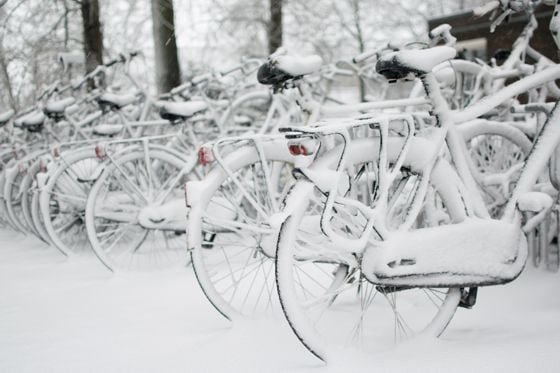
Safe on the road: Cycling in winter and snow
Especially in winter, the motto is: Safety first! Therefore, adjust not only your clothing but also your riding style to the changed weather conditions.
When riding in curves on ice and snow, anticipatory action is crucial: reduce speed early, focus on the curve exit, and maintain as relaxed a body posture as possible. Apply the front brake gently and shift your weight onto the outer, lower pedal for more stability. After the apex of the curve, gradually regain grip by pressing the bike into the ground with your arms and legs. Then accelerate slowly to prevent the rear wheel from slipping.
Learn more about riding techniques in snow and cold in our article "Mountain Biking in Winter".
We hope we have been able to give you some helpful tips and wish you a warm and safe winter season. You can find more information about cycling in our magazine. Are you missing suitable cycling clothes for the winter? Then vists the owayo shop now and find a suitable design for your winter cycling outfit.
Images: Cover image: ©istock/GibsonPictures, Image 1: ©istock/GibsonPictures, Image 2: ©istock/GibsonPictures, Image 4: ©istock/ivandan
